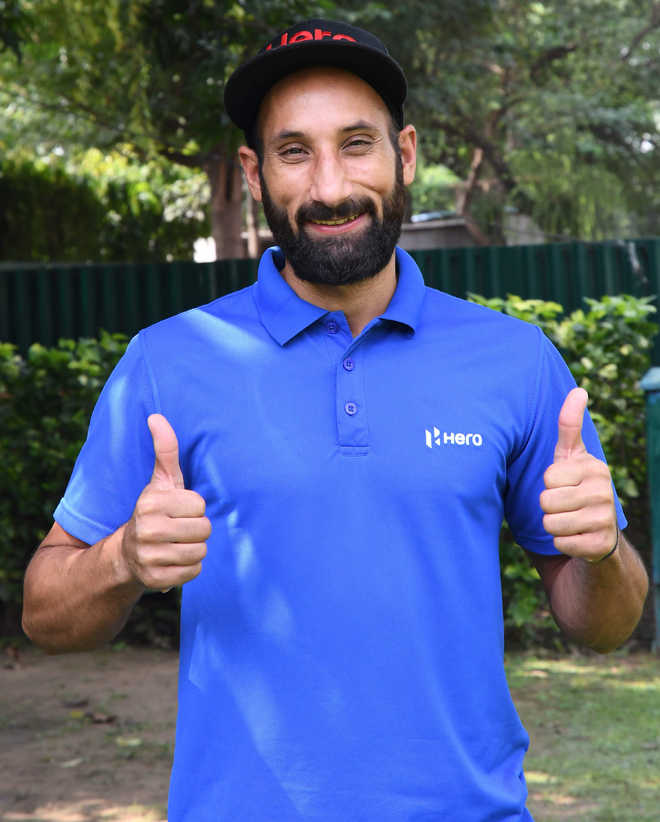Retiring Sardar leaves behind an inexperienced midfield
Indervir Grewal
Tribune News Service
Chandigarh, september 13
Sardar Singh says that not being named in the core group had nothing to do with his decision to retire. He had already had discussions with the players, coaching staff and federation after the Asian Games, and he came to the decision after “speaking with his family”. Sardar said that he had played enough hockey. But at the mention of the timing of his retirement, so close to the World Cup, especially as the midfield has been criticised for being unsettled and inexperienced, the 32-year-old’s face betrayed his unanimated demeanour for a moment. He nodded in agreement, suggesting that he thought the team still needed his experience.
Sardar’s retirement was a long time coming. The 2016 Olympics would have been the perfect time. But even though he was past his prime at that point, he persisted, and despite being dropped in 2017 and earlier this year, he made a return.
Even after announcing his retirement, the former India captain refuses to accept that he could no longer fit in the national team. He said he was fit enough to play for two more years, and at the Asian Games, expressed his desire to play in his third Olympics, at the 2020 Tokyo Games. But his exclusion from the core group yesterday, three months before the World Cup, was a clear indication from the team management and Hockey India that he would not make another comeback.
Young at centre
The timing of the decision and the dilly-dallying on the federation’s part is questionable, though. In hockey, nations always plan in cycles — from one Olympic Games to the next, and from a World Cup to the next. Therefore, it is surprising to see HI exclude Sardar right before the World Cup, especially as they let him go on after the Rio Olympics. Sardar’s position in the team was first questioned in early 2016, when Roelant Oltmans said Sardar was holding up play in the midfield. Sardar’s role in the team had never been settled — some coaches used him as the sweeper-back, while others played him in the midfield. But Oltmans’ decision to take him to Rio as a forward suggested Sardar’s usefulness on the field had become very limited. However, his experience was vital for the team; and going into the World Cup, experience, or the lack of it, in the midfield will be vital.
Little experience
In the core group announced on Wednesday, Manpreet Singh (with over 225 caps), Kothajit Singh and Chinglensana Singh (both over 180 caps) are the most experienced midfielders. Surender Kumar has almost 100 caps. But Surender and Kothajit are defensive midfielders. All the rest have played less than 40 matches each.
It’s a cause of concern. At the Asian Games, it was India’s midfield that failed to control the match against Malaysia. The same was the case at the Commonwealth Games. Sardar played in the Asian Games but his role in the midfield was very limited. This had been the case since the 2016 Olympics. But if he was retained only for his experience, then HI should have used Sardar to nurture younger players. Youngsters, including the members of the Junior World Cup team, should have been given international exposure, at smaller tournaments in the beginning. But the constant firing of coaches has built fear; and instead of nurturing future players, most coaches in the last decade have been more concerned about results.
Instead of trying out youngsters, coaches usually fell back on players who had been tested earlier and had some experience. But many of these players had little potential and are not part the core group now. There are many in the core group who made their debuts either late last year or early this year. On the other hand, Sardar played almost 60 matches since the Olympics. And he doesn't find his name in that list.
Right intent
High performance director David John and former coach Sjoerd Marijne had tried widening the pool by bringing in more youngsters.
But the fourth-place finish in CWG, where Marijne had taken a young team without Sardar, led to the Dutchman’s removal. Harendra Singh brought Sardar back again, but after just two tournaments, excluded him again. Ironically, Sardar praised Marijne’s intentions on Thursday. “You see when I missed CWG, that time the new coaches had said that everyone from the 33-member core group would get a chance, and after that the best players would be taken to major tournaments. I think their thought process was right,” Sardar said. “But now the new players we have, they were given chance in the World League (last December) and CWG,” he added.
But it is a case of too little too late. Olympics bronze medallist Col. Balbir Singh said that it was unfair to expect great performances at a World Cup from players who have only played 10 or 20 matches. Sardar said there was only one option left now. “The responsibility is on the seniors. They should spend as much time as possible with the youngsters off the field. This is the only option now,” Sardar said.









